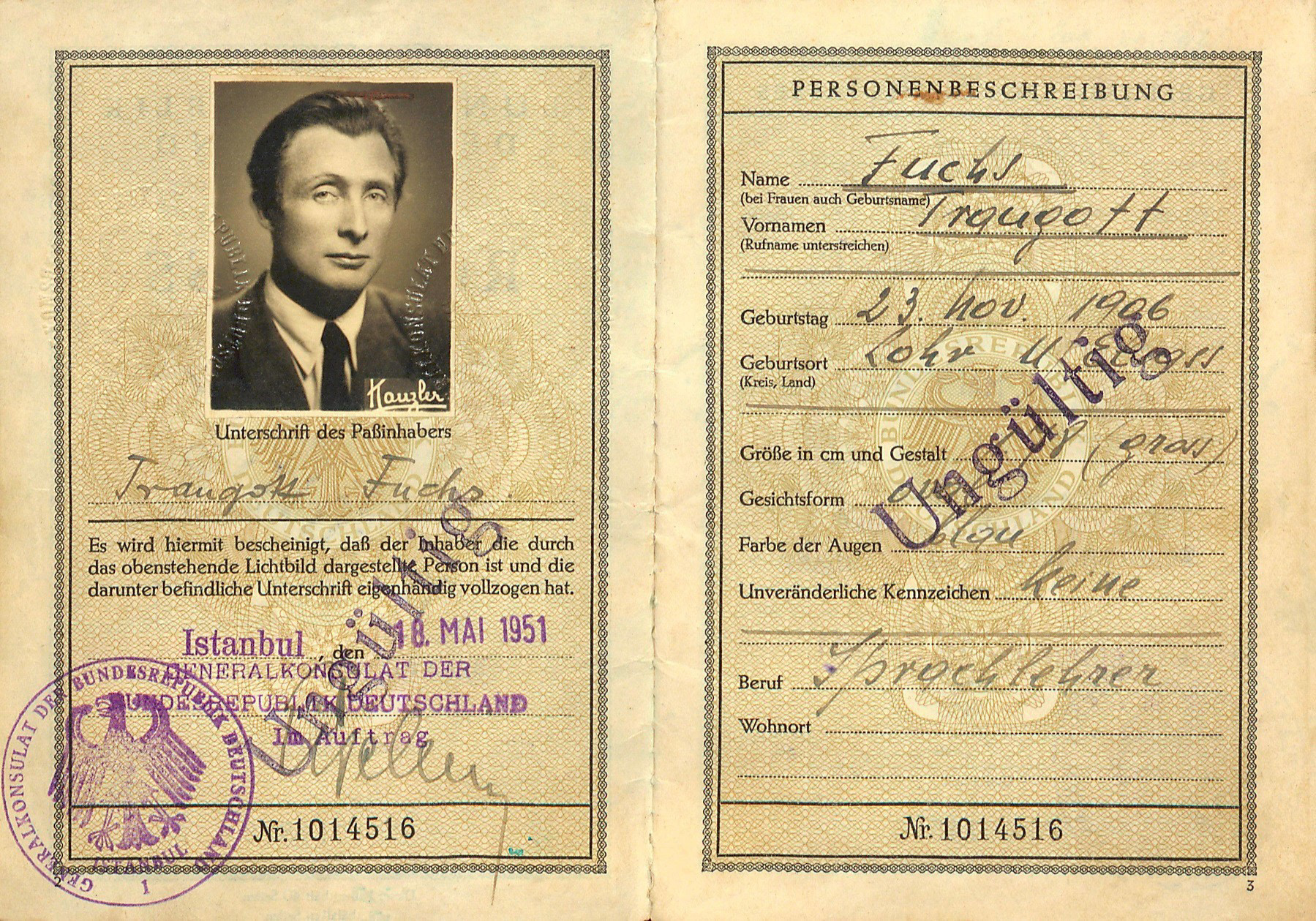1906-1997, Lohr/Elsass, Istanbul, Çorum

Self Portrait Traugott Fuchs, approximately 1940 Source: Hermann Fuchs, Wikimedia, CC

Excerpt from a Günaydın notebook of Traugott Fuchs in the years 1977/78 Source: Archive of Boğaziçi Üniversitesi, https://bogaziciarsivleri.bogazici.edu.tr/en/exhibition/fuchs.php

Passport of Traugott Fuchs issued in Turkey in 1951 Source: Archive of Boğaziçi Üniversitesi, https://bogaziciarsivleri.bogazici.edu.tr/en/exhibition/fuchs.php
In the German-speaking world, Traugott Fuchs remains a relatively overlooked figure among the intellectuals who fled Nazi Germany to Turkey. Yet his contributions to art, literature, and academia were profound, shaping Turkish-German cultural exchange in ways that are only now being fully recognized. His extensive and largely unexplored archive, housed at Boğaziçi University, offers invaluable insight into his multifaceted legacy. One particularly remarkable time capsule is his collection of meticulously crafted collage notebooks, where he documented articles from the 1970s and 1980s in the newspaper Günaydın, capturing the sociopolitical pulse of the era.
His story belongs in the TAM Museum not only as part of the history of German exile intellectuals but also as a testament to the long-standing cultural and intellectual bridges between Germany and Turkey. His work embodies themes of displacement, adaptation, and artistic expression in exile—key narratives that continue to shape transnational identities today.
But how did Traugott Fuchs end up in Turkey in the first place?
The begining of relocations
Born the son of a Protestant priest in Lohr, Alsace-Lorraine, Fuchs and his family had to relocate to Schmalkalden, Thuringia, after World War I, as Alsace-Lorraine became part of France. This marked only the beginning of many more relocations in Fuchs’ biography.
Exile
Fuchs continued changing places when he pursued studies in Romance languages, literature, art history, and philosophy at universities in Berlin, Heidelberg, Marburg, and Cologne. Under renowned scholars like Karl Jaspers and Leo Spitzer he was mentored on a high intellectual level. When the Nazis dismissed Spitzer - a distinguished professor of Romance languages and literature, under whom Fuchs served as an assistant - in 1933 due to his Jewish heritage, Fuchs protested and faced persecution himself. In 1934, he followed Spitzer to Istanbul, joining a wave of exiled scholars who helped shape the Turkish academia.
Establishing new study areas in Istanbul
Fuchs played a key role in founding German Studies at Istanbul University while also teaching French and German literature at Robert College, later Boğaziçi University. His impact reached far beyond academia—through his poetry, paintings, and writings, he vividly captured Turkey’s landscapes and cultural transformations, making him a crucial contemporary witness to a dynamic era of change.
Internment in Çorum and enduring affiliation to Turkish society
During World War II, Fuchs was interned in Çorum by the İnönü government, an experience that profoundly marked his artistic and academic work. Despite personal hardships, including the loss of his doctoral dissertation in a fire, he remained dedicated to his new home in Turkey and to fostering cross-cultural understanding. Until his retirement in 1983, he continued to inspire generations of students, bridging European and Turkish perspectives. However, this seems to apply primarily to Turkish perspectives, while it is less recognized in Germany.
Traugott Fuchs’ heritage
His vast intellectual and artistic legacy is preserved in the Traugott Fuchs Cultural and Historical Heritage Archive at Boğaziçi University, where scholars continue to explore his contributions to German exile history, Turkish modernity, and the notion of Heimat in exile.
Source:
Burcu Dogramaci. "Traugott Fuchs." METROMOD Archive, 2021, https://archive.metromod.net/viewer.p/69/2949/object/5138-10832903, last modified: 14-09-2021
https://we-refugees-archive.org/cities/istanbul-historisch/editorial/#
His story belongs in the TAM Museum not only as part of the history of German exile intellectuals but also as a testament to the long-standing cultural and intellectual bridges between Germany and Turkey. His work embodies themes of displacement, adaptation, and artistic expression in exile—key narratives that continue to shape transnational identities today.
But how did Traugott Fuchs end up in Turkey in the first place?
The begining of relocations
Born the son of a Protestant priest in Lohr, Alsace-Lorraine, Fuchs and his family had to relocate to Schmalkalden, Thuringia, after World War I, as Alsace-Lorraine became part of France. This marked only the beginning of many more relocations in Fuchs’ biography.
Exile
Fuchs continued changing places when he pursued studies in Romance languages, literature, art history, and philosophy at universities in Berlin, Heidelberg, Marburg, and Cologne. Under renowned scholars like Karl Jaspers and Leo Spitzer he was mentored on a high intellectual level. When the Nazis dismissed Spitzer - a distinguished professor of Romance languages and literature, under whom Fuchs served as an assistant - in 1933 due to his Jewish heritage, Fuchs protested and faced persecution himself. In 1934, he followed Spitzer to Istanbul, joining a wave of exiled scholars who helped shape the Turkish academia.
Establishing new study areas in Istanbul
Fuchs played a key role in founding German Studies at Istanbul University while also teaching French and German literature at Robert College, later Boğaziçi University. His impact reached far beyond academia—through his poetry, paintings, and writings, he vividly captured Turkey’s landscapes and cultural transformations, making him a crucial contemporary witness to a dynamic era of change.
Internment in Çorum and enduring affiliation to Turkish society
During World War II, Fuchs was interned in Çorum by the İnönü government, an experience that profoundly marked his artistic and academic work. Despite personal hardships, including the loss of his doctoral dissertation in a fire, he remained dedicated to his new home in Turkey and to fostering cross-cultural understanding. Until his retirement in 1983, he continued to inspire generations of students, bridging European and Turkish perspectives. However, this seems to apply primarily to Turkish perspectives, while it is less recognized in Germany.
Traugott Fuchs’ heritage
His vast intellectual and artistic legacy is preserved in the Traugott Fuchs Cultural and Historical Heritage Archive at Boğaziçi University, where scholars continue to explore his contributions to German exile history, Turkish modernity, and the notion of Heimat in exile.
Source:
Burcu Dogramaci. "Traugott Fuchs." METROMOD Archive, 2021, https://archive.metromod.net/viewer.p/69/2949/object/5138-10832903, last modified: 14-09-2021
https://we-refugees-archive.org/cities/istanbul-historisch/editorial/#
